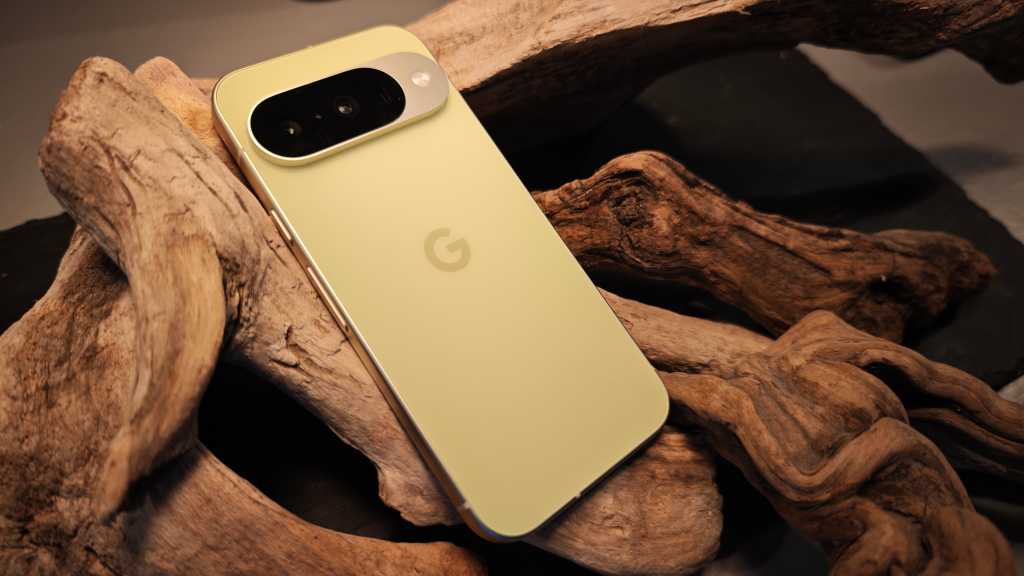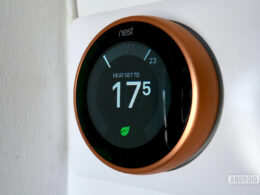At a glance
Expert’s Rating
Pros
- Qi2 magnetic charging
- Premium design
- Excellent cameras
- Useful AI features
Cons
- 128GB doesn’t feel like enough
- Mixed battery life
Our Verdict
Despite the same price as last year, Google has added some big additions, including magnetic charging for the first time on an Android flagship and a telephoto camera. There are other improvements, and aside from a few small niggles, the Pixel 10 makes for an obvious go-to option for anyone looking for an entry-level flagship phone.
Price When Reviewed
This value will show the geolocated pricing text for product undefined
Best Pricing Today
Price When Reviewed
From $799
Best Prices Today: Google Pixel 10
The Google Pixel 10 series of phones has arrived, and there’s no ‘Edge’, Air’ or ‘Max’ in sight.
Instead, the phones mirror the previous quartet and stick at the same prices (mostly) while bringing a selection of upgrades – one of which will likely be a catalyst for the entire Android phone market.
It’s nothing new as the iPhone has had MagSafe for a number of years, but Qi2, which is effectively the same technology, brings magnetic charging and accessories to an Android flagship for the first time.
The regular Pixel 10 on review here is also interesting in a number of other ways. For starters, it has no less than three colourways you can’t get on any other Pixel 10, while Google has also now added a telephoto lens to the camera module, giving you optical zoom at your fingertips.
Although I have a few minor quibbles, for what seemed like a phone to skip in the months leading up to its release (based on early leaks), I now think it’s the default affordable Android flagship smartphone that most people should buy.
Let’s dive in…
Design & Build
- Same look, new colours
- Minor design tweaks
- One big invisible upgrade
Smartphones often go through a cycle of keeping the same design for two or three generations before introducing an overhaul. The Pixel 9 series brought a new look, so it’s understandable that the Pixel 10 is effectively the same.
It’s hard to tell the new phone apart from its predecessor unless you look closely at small things. For example, the bottom of the phone now looks more pleasing with symmetrical holes on either side of the USB port (one mic and one speaker).
The SIM-card tray has also moved to the top of the phone, which I find quite disconcerting as it’s so unusual, but it’s quickly forgotten about. This doesn’t apply in the US, where the phone is now eSIM only, matching the iPhone.
I got the short straw with Lemongrass. Maybe you love it, but it’s one of the worst phone colours I’ve ever seen
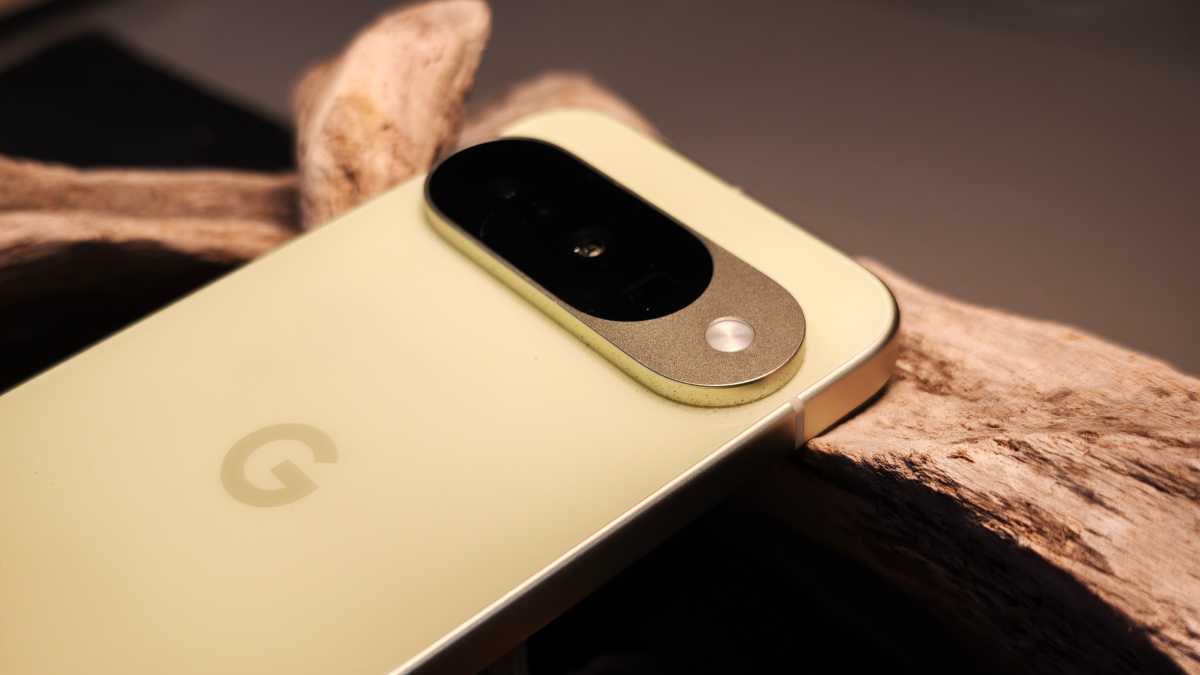
Chris Martin / Foundry
More important than those small changes is the new set of colourways Google has ushered in. It’s more dramatic for this regular model, where there are no fewer than three new colours.
Obsidian remains as the plain black option, then you have Frost, Indigo and Lemongrass to choose from – all of which are exclusive to this phone. The Pro models have a more grown-up and restrained set of hues.
Whether this is good or bad news depends on your taste, of course. I had my fingers crossed for an Indigo sample, which is a throwback to the ‘Really Blue’ of the first-gen Pixel phones.
However, as you can see, I got the short straw with Lemongrass. Maybe you love it (I may be too old to be the target market for this), but it’s one of the worst phone colours I’ve ever seen.
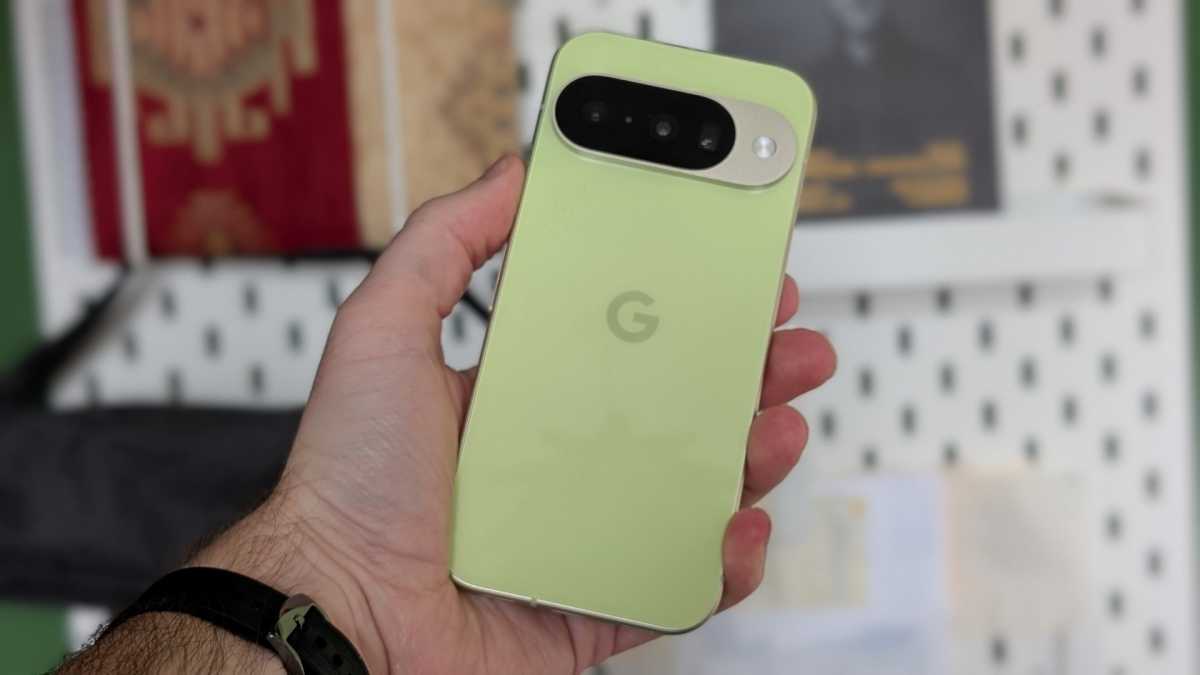
Chris Martin / Foundry
Somehow, depending on the light, it’s a garish foam banana yellow or a sickly green. The metal frame and camera bar are a pale gold, which I almost like, but the rear cover is too lurid for this to matter.
The official Pixelsnap case in the matching colour has a more pastel tone due to its matt finish, but it’s still far from my cup of tea. I still wish Google would make a more varied range of official cases, including the fabric ones, which were great.
This year’s version is a mixed bag. It’s well made (no marks after 2 weeks of use), uses 42% recycled material and offers good protection, but the outside is oddly slippery – far more than the Pixel 9‘s. Inside is a nice microfibre lining and a faint circle hinting at a major Pixel 10 upgrade.
Google adding Qi2 to the Pixel 10 will no doubt be a catalyst for the Android market to follow suit
Pixelsnap is far more than just the official case. It’s a whole range of accessories, because the Pixel 10 phones have Qi2, a wireless charging standard which involves magnets, so you can easily and accurately attach chargers and other accessories.

Chris Martin / Foundry
It’s essentially the same thing as MagSafe on the iPhone, and you can even use thousands of MagSafe accessories with the Pixel 10 – with some caveats.
While MagSafe has been around for years, it’s been sorely missing from the Android world. HMD introduced it on the Skyline, but it was a phone almost nobody cared about or took notice of.
Google adding Qi2 to the Pixel 10 will no doubt be a catalyst for the Android market to follow suit.
This addition is one of the reasons the phone is slightly thicker and heavier than its predecessor, but only marginally at an extra 0.1mm and 6g, so it’s not noticeable.
Once again, it’s a comfortable and balanced phone to hold and use. It’s also nicely compact, though the iPhone 16 and Galaxy S25 beat it in that regard in exchange for slightly smaller screens.
Screen & Speakers
- Essentially the same screen
- Higher brightness
- Good quality audio
Speaking of screens, the Pixel 10 is largely unchanged from the Pixel 9. That means you get what is pretty standard for an entry-level flagship smartphone in 2025.
It’s 6.3 inches, uses an OLED panel with the same resolution and 120Hz refresh rate as before. In fact, all the specs of this Actua Display are the same apart from the brightness, which has been improved.
The Pixel 10 can now hit 1,800 nits (HDR) and up to 2,700 nits (peak brightness), which is 200 and 300 nits better than its predecessor, respectively. It’s rarely noticeable side-by-side but welcome nonetheless.
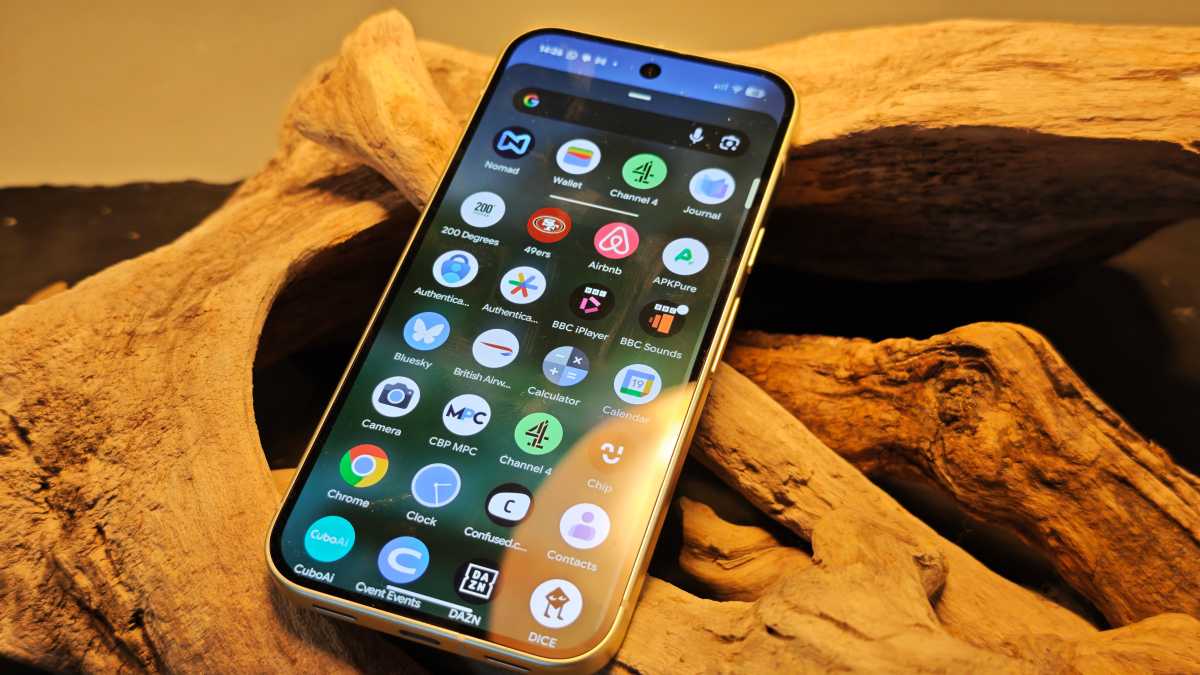
Chris Martin / Foundry
The Pixel 10 Pro phones can go even further at up to 3,300 nits peak brightness, depending on which model you choose. But the phone already has excellent visibility in bright environments, so there’s not much to gain.
It’s one of a fairly long list of things the regular Pixel 10 misses out on. The other key one here is the Smooth Display high refresh rate only going from 60-120Hz, while the Pro models can dip to 1Hz to help save battery when not required.
The decent ultrasonic fingerprint scanner is still embedded into the screen, and the Pixel 10 still has stereo speakers, as you would expect from a flagship. They’re very good indeed, with plenty of velocity, clarity and stereo separation. Things get a bit messier at higher volume levels, but that’s nothing unusual.
Specs & Performance
- Tensor G5 chipset
- 12GB RAM
- Two storage options
The Pixel 10 isn’t particularly exciting in terms of its core specs, something I imagine most people buying it won’t care that much anyway, so I’ll keep it brief.
As with most smartphones, the Pixel 10 comes with a new processor. This time around, it’s Google’s own Tensor G5, which now reaches a 3nm manufacturing process.
As you’ll see below, the phone doesn’t benchmark that well compared to rivals in raw performance tests like Geekbench 6. However, I’d wager Google isn’t trying to win that Top Trumps battle anyway and, again, most people buying this phone won’t give an iota.
Sure, the CPU is faster than the Tensor G4 at 34% according to Google, but it’s the TPU where AI is handled, which gets the biggest improvement at 60%. With the firm leaning so hard into AI features like Gemini, it makes total sense.
Percentages aside, what’s important is how the phone runs on a daily basis. For me, the Pixel 10 is perfectly smooth in day-to-day usage, just as Pixel phones always are.
Once again, there’s 12GB of RAM to help keep everything smooth and only two options for storage at 128- or 256GB.

Chris Martin / Foundry
The former now feels small and a bit stingy for a phone this expensive, especially when Apple’s iPhone 17 now comes with 256GB as standard for the same price.
The Galaxy S25 is a similar story, but Samsung also offers a 512GB model and at launch offers double the storage at no extra cost for early adopters.
According to GSMArena, the smaller capacity Pixel 10 gets UFS 3.1 storage, while the 256GB model is UFS 4.0 at almost double the read/write speed. However, this is once again something that most people won’t notice.
For me, the Pixel 10 is perfectly smooth in day-to-day usage, just as Pixel phones always are
If you’re a potential Pixel 10 buyer who’s a bit more nerdy and into specs, the phone misses out on quite a long list of things that you get with the 10 Pro models.
This includes Wi-Fi 7, as you only get 6e, and you don’t get things like Ultra-Wideband (UWB), Thread compatibility or a Temperature sensor on the back. But I highly doubt that any of these will be dealbreakers.
Google Pixel 10 benchmarks
Cameras
- New set of rear cameras
- Including the addition of a dedicated telephoto lens
- Yet more AI features
It’s all change when it comes to the Pixel 10 cameras, as the phone no longer mirrors some of the cameras found on the Pro models. Instead, the main and ultrawide shooters appear to be the ones found on the much cheaper Pixel 9a.
You get a 48Mp main camera, which only drops 2Mp on the Pixel 9, but it’s a smaller sensor with smaller pixels. The ultrawide drops from 48- down to 13Mp with a slower aperture and slightly narrower field of view, albeit with a larger sensor.

Chris Martin / Foundry
These mid-range cameras are likely to keep costs down in order to add a telephoto lens, so it’s swings and roundabouts. Normally, you need to buy a Pro-level Pixel phone to get optical zoom, but not anymore.
Anyone nitpicking over the specific specs of the cameras probably isn’t considering this phone anyway. Over the years, Google has proven it can do a lot with lower megapixel cameras compared to rivals, with excellent software processing, and that’s no different here.
Once again, the Pixel 10 is a top-notch point-and-shoot camera, regardless of which camera you are using. All three rear cameras are capable of capturing good-looking photos with good exposure and natural colour reproduction.
The selfie camera – the only one to remain unchanged from last year – is also excellent.
The name of the game here is versatility, with the main camera being the high-resolution go-to, but having the option to switch to the others when you need them.
The new telephoto lens offers 5x optical zoom, which is impressive. Many are 3x and require a fourth camera to get you zoomed in any further. Digital zoom extends to 20x, whereas the Pro models can now hit a whopping 100x, although we didn’t find it to be overly impressive anyway.
Every year, Google adds new AI features to the Pixel phones and the cameras are always one of the key areas. This time around, Camera Coach is the headline addition and aims to help you take better photos.
Once again, the Pixel 10 is a top-notch point-and-shoot camera, regardless of which camera you are using
When in the app, you simply tap the icon at the top when you’re camera is pointing at the scene or subject. The Camera Coach will then give you a detailed set of instructions, such as changing the camera lens, mode or the way you are framing the shot.

Chris Martin / Foundry
It’s impressive, if a tad patronising at times. It also takes a while to go through the steps, so you can’t use it for anything time sensitive, but for the right person in the right situation it could make a huge difference.
There are more features, such as Add Me for putting the photographer into group photos and Auto Best Take, which will now automatically combine the best shots to make sure everyone in a selfie is smiling. Ask Photos introduces conversational editing with Gemini, but it’s limited to the US for now.
Battery Life & Charging
- Bigger 4970mAh battery
- Faster 30W wired charging
- Qi2 magnetic wireless charging
There are a number of changes and improvements for the Pixel 10 here. For starters, the battery is almost 300mAh bigger at 4970mAh, which is partly why the phone is heavier this year. It’s even bigger than the 4870mAh one found in the 10 Pro.
Combined with the more efficient 3nm Tensor G5, this should result in better battery life. A PCMark benchmark result of 14 hours and 55 minutes is impressive – an improvement of almost an hour on the Pixel 9.
However, in real-world testing, I still don’t find this phone to be the most comfortable in battery life. Inconsistent is probably the best word, with some days faring better than others despite very similar usage.
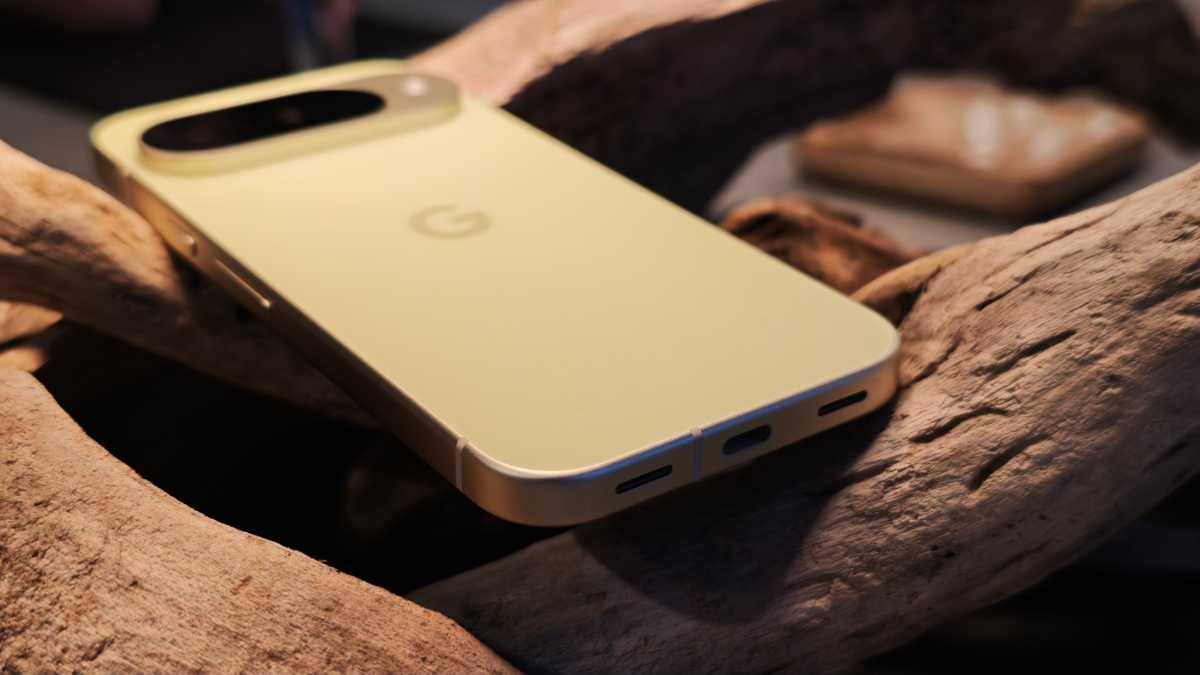
Chris Martin / Foundry
I noted in my Pixel 9 review that the battery saver popped up more than previous models, and I still find it reaching this point (20%) more than I’d like. The Pixel 10 can certainly last a day with some juice left, but other times it seems to disappear like a leaky bucket trying to hold water.
Perhaps things will improve over time, but for now, if I’m leaving the house with the Pixel 10, I’m aiming to take a charger or power bank with me just in case.
Moving onto charging and things have improved in a number of ways, with wired charging now hitting 30W (up 3W), meaning you can get 55% in 30 minutes with the right charger.
The Pixel 10 can certainly last a day with some juice left, but other times it seems to disappear like a leaky bucket trying to hold water
That’s easier said than done with today’s mess of USB charging standards and versions. It’s not simply about the wattage displayed on the side of the charger.
For example, the 67W Xiaomi charger I had to hand didn’t provide fast charging on the Pixel 10, but a 125W Motorola one did. You’re mainly looking for one with USB PD (Power Delivery).
With the Motorola, I got 56% in 30 minutes. It’s decent, albeit well behind the fastest charging phones around. Key rivals such as Samsung and Apple aren’t far ahead, though.

Chris Martin / Foundry
Wireless charging remains at 15W, but the big news is the addition of Qi2, which brings magnets into the equation. Google has a range of Pixelsnap accessories especially for this, but you can also use a plethora of MagSafe accessories too (with some caveats like potential slower charging speeds).
It’s a huge upgrade for convenience and marks the first flagship phone (series) to get the feature. No doubt, others will be far more inclined to follow suit.
There are a couple of downsides here to be aware of. The Pixel 10 Pro XL is the only model in the range to get faster Qi2.2, which is 25W, and the Pixel 10 is officially not compatible with the Pixel Stand (either generation), though it will charge slowly anyway.
Software & AI
- Android 16 with Material 3 Expressive
- Various new AI features
- Market-leading software support
As you’d expect, the Pixel 10 runs Google’s latest software version, Android 16, out of the box. And you still get the excellent promise of seven years of software support for both OS and security updates.
Although it launched months ago, the Pixel 10 phones include the long-awaited Material 3 Expressive update. This is a substantial overhaul to the way the interface looks and works.
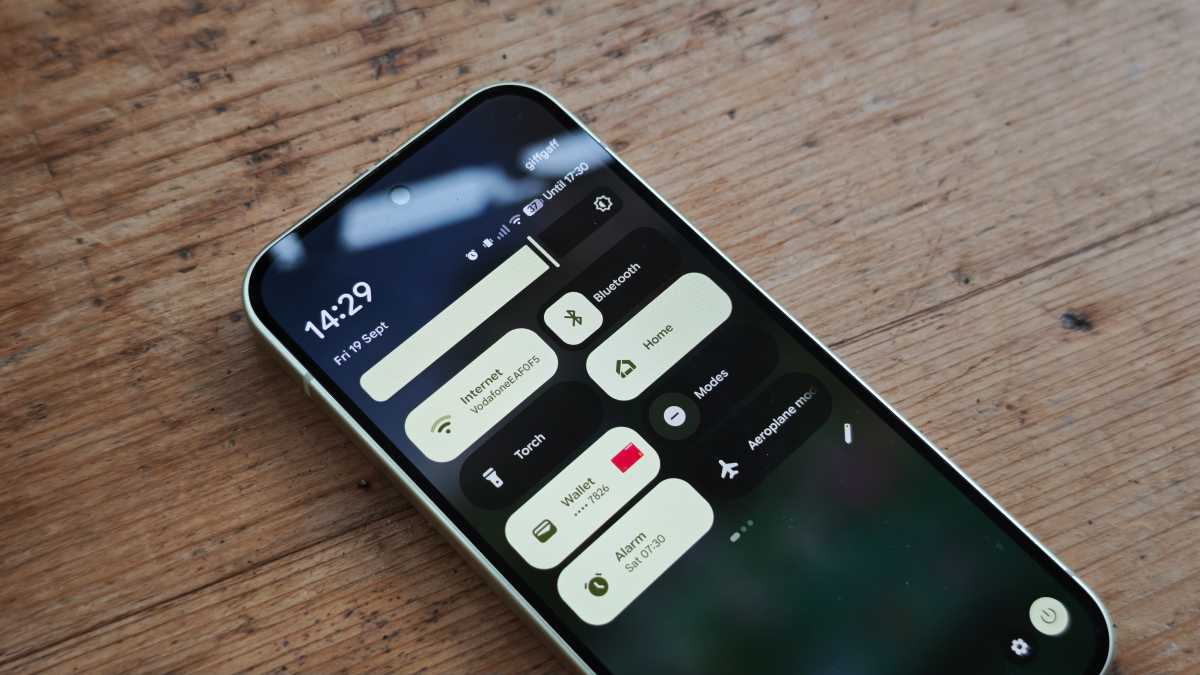
Chris Martin / Foundry
As a long-time Pixel tester and user, it’s taking me some time to get used to it. While the intention is that buttons, sliders and the like are easier to interact with, I can’t help but feel Android has gotten more garish and child-like with this update.
It’s perhaps a sign of my age and inclination to keep things the same, but so far, I’m not much of a fan. Luckily, it doesn’t affect daily usage too much – mainly the quick settings for me – and with some time to tinker, things can no doubt be improved.
It seems impossible to hide from AI at the moment and the Pixel 10 is very much an AI-focused device, with Google’s huge efforts into this area in recent years. Gemini is everywhere now – it’s not just a replacement for the Google Assistant to ask questions and turn lights on.
Whether you like AI or not, Google does a much better job of integrating artificial intelligence into the experience than its rivals. Features are not half-baked either, and there’s more care into teaching users what the phone can do and how to do it.

Chris Martin / Foundry
Apart from the camera features mentioned earlier, the Pixel 10 comes with a range of new AI tricks, starting with Magic Cue. This aims to do all sorts of proactive things to make your life easier, but I haven’t seen it pop up yet so it may take some time to kick in.
Google does a much better job of integrating artificial intelligence into the experience than its rivals
It’s not one for me, but there’s also the new Journal app if that takes your fancy. It’s a place to, well, journal but with AI jumping in to help with “writing inspiration and track how you’re feeling”. Thanks, but no thanks.
Those more willing to embrace AI than me might want to consider a Pixel 10 Pro model where you get a free year of Google AI Pro, including tools like Veo 3 and NotebookLM. It costs £18.99/$19.99 per month thereafter.
Price & Availability
There’s no price change for the Pixel 10 range, bar the XL model now starting at 256GB, which sort of gives it a price rise of sorts.
This means the cheapest model on test here will set you back £799/$799 for a 128GB model.
There’s only one other option with 256GB priced at £899/$899.
Despite Google sticking to the same price, the Pixel 10 lags behind the Galaxy S25, which also has a 512GB capacity. Meanwhile, the iPhone 17 comes with at least 256GB for the same price.
You can buy the Pixel 10 from the official store as well as a long list of retailers, including Amazon.
Should you buy the Google Pixel 10?
As entry-level all-rounder flagship phones go, the Pixel 10 is easily one of the best options on the market.
It ticks a heck of a lot of boxes, including an attractive design (Lemongrass colourway excluded), solid display, great cameras and a user-friendly interface with genuinely useful AI additions.
The addition of a telephoto lens and Qi2 magnetic charging are both very welcome and should be the new normal for Android phones going forward.
128GB is starting to feel a bit small for a flagship, and there’s better battery life to be found elsewhere, but the Pixel 10 is a fantastic phone at this price point. For people with £800/$800 to spend (or a similar amount on contract), it’s my go-to recommendation.
Sure, you miss out on a reasonable list of things the Pro models come with, but that’s understandable. I don’t think many Pixel 10 users will notice, anyway.
Specs
- Android 16 with seven years of updates
- 6.3-inch FHD+ 120Hz OLED
- Ultrasonic in-display fingerprint scanner
- Face Unlock
- Google Tensor G5 chipset
- 12GB RAM
- 128/256GB non-expandable storage
- 4970mAh battery
- 30W wired charging
- 15W Qi2 wireless charging
- Reverse wireless charging
- 48Mp f/1.7 main camera
- 13Mp f/2.2 ultrawide camera
- 10.8Mp f/3.1 5x telephoto camera
- 10.5Mp f/2.2 front camera
- Dual stereo speakers
- USB-C
- 5G
- NanoSIM + eSIM
- Wi-Fi 6e
- Bluetooth 6.0
- IP68
- Gorilla Glass Victus 2 (front and back)
- 152.8 x 72 x 8.6mm
- 204g
Link do Autor





